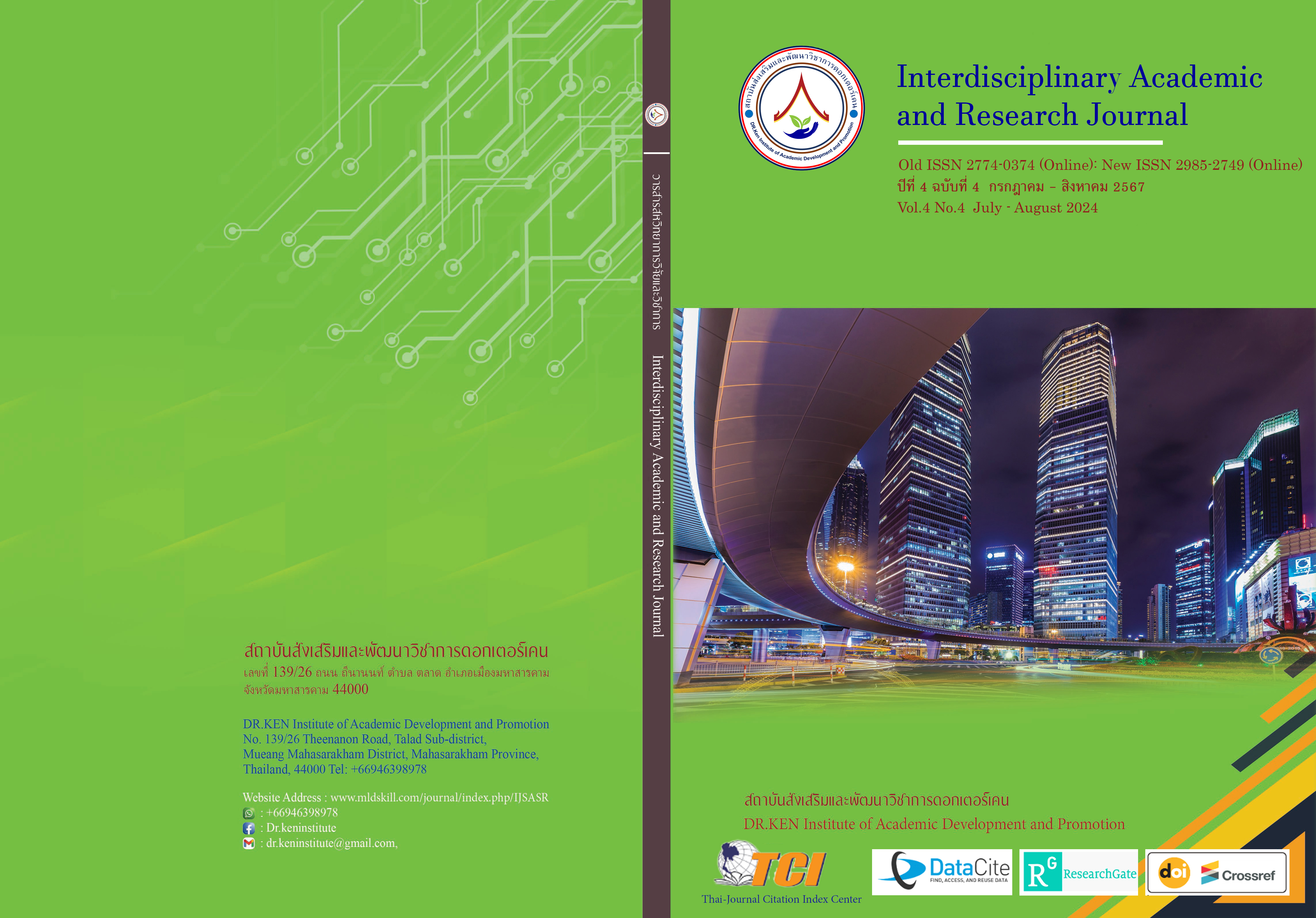The Development of Thai Learning Achievement on Pali-Sanskrit Loan Words in the Thai-Language of Matthayomsueksa 2 Students by Using a Concept Attainment Model with Boardgame
DOI:
https://doi.org/10.60027/iarj.2024.277361Keywords:
Pali and Sanskrit Language in the Thai Language; , Using a Concept Attainment Model;, Board GamesAbstract
Background and Aims: At present, the Pali-Sanskrit language has been mixed into the Thai language more than words borrowed from other languages, and learners themselves still do not understand the differences in the language clearly. Because there is no concept of each language, the purposes of this research were to 1) compare the achievement on Bali-Sanskrit loan words in Thai languages of Matthayomsueksa 2 students before and after using a concept attainment model with boardgame. 2) study students’ opinions on Thai of Matthayomsueksa 2 students by using a concept attainment model with the board game. The sample group studies used in this study were 30 secondary from Watwainiao (PunsiriWitthaya) School Thamaka Kanchanaburi in the second semester of academic 2023. Derived from Simple random sampling. By using the classroom as a random unit.
Methodology: The instrument of this research was 1) learning Management plans by using a concept attainment model with boardgame. 2) board game. 3) achievement tests on students’ opinions towards learning by using a concept attainment model and board game. 4) questionnaires on students’ opinions towards learning by using a concept attainment model with the board game. The data were analyzed by mean, standard deviation (S.D), and t-test dependent samples.
Results: The research results found that 1) Thai literature achievement of Matthayomsueksa 2 students after learning by using a concept attainment model with boardgame have an average of 20. Which was higher than before studying with an average of 14.93 with statistical significance at the 0.5 level. 2) The opinions of secondary towards learning by using a concept attainment model with board games were the highest positive. When considering each aspect, it was found that Students' opinions were in the average range, most agreeing is In order: The atmosphere in organizing learning activities, followed by the benefits received from learning, and the aspect of organizing learning activities is the last. Each side has the following details.
Atmosphere in organizing learning activities The students' opinions were included in the most agreed criteria. When considering each item in order as follows: Number 1 is that students are happy in organizing learning activities. Number 2 is that students are enthusiastic in learning activities and students liked organizing learning through concept teaching formats together with board games last.
Benefits received from learning The students' opinions were included in the most agreed criteria. When considering each item in order as follows: Number 1 is that students have a role and participate in activities. Number 2 is that students can apply knowledge gained from learning activities. in daily life and students have more knowledge and understanding of Pali-Sanskrit words used in the Thai language in the last order.
Organizing learning activities The students' opinions were included in the most agreed criteria. When considering each item in order as follows: Number 1 is that students are happy in organizing learning activities. Number 2 is that students are enthusiastic about learning activities and like organizing learning through concept teaching formats and board games, last in order.
Conclusion: Thai literature achievement among Matthayomsueksa 2 students significantly improved using a concept attainment model with board games, exhibiting a statistically significant increase from 14.93 to 20. Furthermore, secondary students showed a great deal of support for this method, stressing the value of positive learning environments and well-planned activities in addition to the observable advantages they experienced.
References
กิ่งกาญจน์ บูรณสินวัฒนกูล. (2562). การพัฒนาสื่อการเรียนรู้บอร์ดเกมการศึกษาเพื่อส่งเสริมความสามารถการเรียนรู้ในรายวิชาพัฒนาการแบบเรียนภาษาไทยและความสุขในการเรียนรู้สำหรับนิสิตระดับปริญญาตรี. กรุงเทพฯ: มหาวิทยาลัยศรีนครินทรวิโรฒ.
กิดานันท์ มลิทอง. (2548). เทคโนโลยีการศึกษาและการสื่อสารการศึกษา. กรุงเทพฯ: อรุณการพิมพ์.
จิรวัฒน์ เพชรรัตน์ และอัมพร ทองใบ. (2556). ภาษาต่างประเทศในภาษาไทย. กรุงเทพฯ : โอเดียนสโตร์.
ฐาปนีย์ ธรรมเมธา (2557). เอกสารคำสอนรายวิชา 468 301 เรื่อง การเลือกการใช้เสื่อการเรียนการสอน. นครปฐม: ภาควิชาเทคโนโลยีการศึกษา คณะศึกษาศาสตร์ มหาวิทยาลัยศิลปากร.
ทิศนา แขมมณี. (2563). ศาสตร์การสอน: องค์ความรู้เพื่อการจัดกระบวนการเรียนรู้ที่มีประสิทธิภาพ. กรุงเทพฯ: สำนักพิมพ์แห่งจุฬาลงกรณ์มหาวิทยาลัย.
โรงเรียนวัดหวายเหนียวปุญสิริวิทยา (2565). หลักสูตรสถานศึกษา กลุ่มสาระการเรียนรู้ภาษาไทย. กาญจนบุรี: โรงเรียนวัดหวายเหนียวปุญสิริวิทยา.
วัชรีย์ เพชรรัตน์. (2553). การรวบรวมคำศัพท์ภาษาบาลีในวิชาภาษาไทยระดับชั้นมัธยมศึกษา. สถาบัน ทดสอบทางการศึกษา.
วิไลวรรณ ตรีศรีชะนะมา. (2537). แนวคิดบางประการเกี่ยวกับความคิดรวบยอด. สารพัฒนาหลักสูตร, วารสารบัณฑิตศึกษา, เชียงใหม่: มหาวิทยาลัยเชียงใหม่
ศรีสุดา จริยากุล. (2551). ระบบการเรียนการสอน. นนทบุรี: มหาวิทยาลัยสุโขทัยธรรมาธิราช.
ศิวนิต อรรถวุฒิกุล. (2555). การผลิตสื่อการศึกษาเชิงสร้างสรรค์. นครปฐม: ภาควิชาเทคโนโลยีทางการศึกษา คณะศึกษาศาสตร์ มหาวิทยาลัยศิลปากร.
สุธิวงศ์ พงศ์ไพบูลย์. (2535). บาลี-สันสกฤตที่สัมพันธ์กับภาษาไทย. พิมพ์ครั้งที่ 3. กรุงเทพฯ: ไทยวัฒนาพานิช.
สุภัคธัช สุธนภิญโญ. (2565). เอกสารคำสอนภาษาต่างประเทศในภาษาไทย. กรุงเทพฯ: มหาวิทยาลัยราชภัฏสวนสุนันทา
สุรางค์ โค้วตระกูล. (2552). จิตวิทยาการศึกษา. พิมพ์ครั้งที่ 11. กรุงเทพมหานคร: โรงพิมพ์แห่งจุฬาลงกรณ์มหาวิทยาลัย.
อัมพร อังศรีพวง. (2545). แนวพัฒนาสื่อการสอนภาษาไทยสรรสร้างสื่อสร้างสรรค์. พิมพ์ครั้งที่ 2. กรุงเทพฯ: ไทยวัฒนาพานิช.
เอื้อน เล่งเจริญ (2535). ภาษาไทยปริทัศน์. กรุงเทพฯ : รวมสาส์น.
Bruner, J. S., Goodnow, J. J., & Austin, G. A. (1956). A study of thinking. John Wiley and Sons.
Crews, A. (2011). “Using Game to Support the Curriculum: Getting Teachers on “Board”.” Knowledge Quest, 40(1), 10 – 13.
Dale, E. (1969). Audio-Visual Methods in Teaching. 3rd editor, New York: The Dryden Press.
Hinebaugh, J.P. (2009). A board game education. R & L Education.
Jahnke, J. C., & Nowaczyk, R. H. (1998). Cognition. New Jersey: Prentice-Hall.
Joyce, B., & Weil, M., and Showers, B. (1992). Model of teaching. 4th edition, Boston: Allyn and Bacon: A Divison of Simon & Schuster, Inc.
Santrock, J.W. (2003). Educational Psychology. 2nd edition. Boston: McGraw-Hill.
Smith, P.L. & Ragan, T.J. (2005). Instructional design. 3rd edition, New Jersey: John Wiley& Sons.
Tinsman, B. (2008). The Game Inventor's Guidebook. Garden City, NY: Morgan James Publishing, LLC.
Treher, E.N. (2011). Learning with board games. Retrieved June 22, 2022 from: https://www.thelearningkey.com/pdf/Board_Games_TLKWhitePaper_May16_2011.pdf
Trybus, J. (2014). Game-based learning: What it is, why it works, and where it’s going. Retrieved 2015, March 4, from http://www.newmedia.org/game-based-learning-what-it-is-why-it-works-and-where-its-going.html
Downloads
Published
How to Cite
Issue
Section
License
Copyright (c) 2024 Interdisciplinary Academic and Research Journal

This work is licensed under a Creative Commons Attribution-NonCommercial-NoDerivatives 4.0 International License.
Copyright on any article in the Interdisciplinary Academic and Research Journal is retained by the author(s) under the under the Creative Commons Attribution-NonCommercial-NoDerivatives 4.0 International License. Permission to use text, content, images, etc. of publication. Any user to read, download, copy, distribute, print, search, or link to the full texts of articles, crawl them for indexing, pass them as data to software, or use them for any other lawful purpose. But do not use it for commercial use or with the intent to benefit any business.
















.png)


